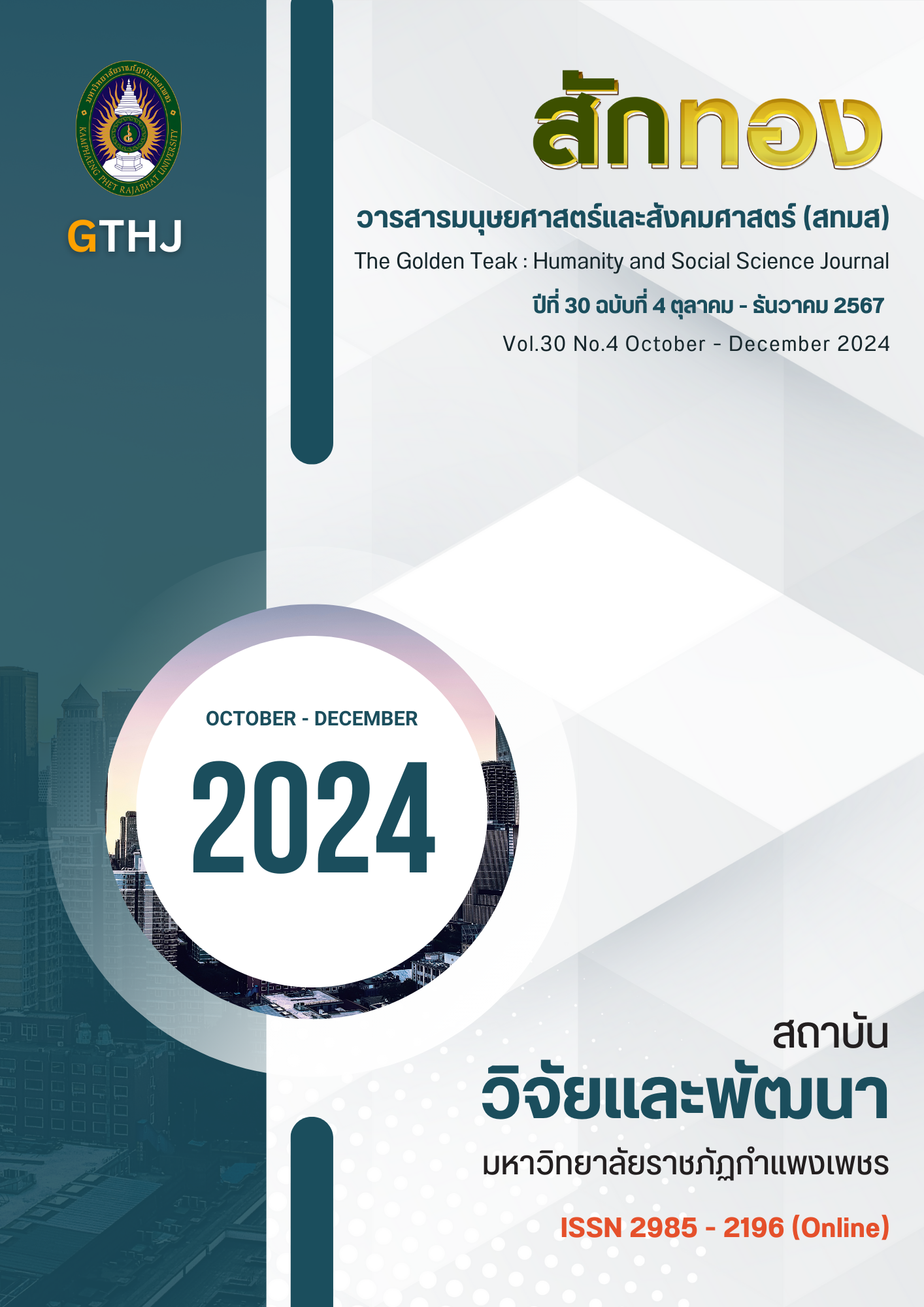Increasing the Potential of Three Generations Through the Development of Tourism Products based on the Local Identity of the Ancient town of Wiang Lor in Chun District, Phayao Province
Main Article Content
Abstract
The purpose of this research were: 1) to improve the quality of tourism products based on community characteristics 2) to enhance the potential between three generations and network partners in the interests of sustainability and 3) to assess the income and second job before and after of the research project participants. The population used in the research was members of three generations: elderly people, working-age people, and youths living in Lo Sub-district and Hong Hin Sub-district, Chun District, Phayao Province. The sample group consisted of 5 community business groups, community leaders, and community members, totaling 50 people. Research methods combine Participatory Research with Action Research including Qualitative Research) together. The methods for analyzing qualitative research data began from the outset until the end of the study. Data analysis was a process of creating intellectual knowledge and enhancing the potential of people over three generations in terms of business operations in Wiang Lo Ancient Town. The result of the study found that the community had a community product identity, classified into 1) natural capital, 2) significant ancient sites, 3) lifestyle and related resources, namely fish in the Ing River, and 4) local wisdom, namely basketwork, using the identity of the training to develop products together with product design experts from the Vassana brand and got prototype souvenir products. The acquired identity was honed in order to create prototype products of auspicious souvenirs that boosted good fortune and morale, while retaining the character of Wiang Lo Ancient Town, in collaboration with specialists or product design scholars from the Vassana Brand. The auspicious souvenirs were made from bamboo strips, a local resource. In addition, basketwork skills were a handicraft that represented knowledge and wisdom inherited from valued ancestors. In relation to objective number 1, product quality development must focus on the following main issues: 1) The local wisdom development, 2) Product quality development, and 3) Developing Creative Tourism Activity In relation to objective number 2, raising the joint potential of three generations and network partners for sustainability to promote the establishment of a community business group with an organizational structure, namely “Wiang Lor Craft” with 20 original members. There is an organizational structure of the group and assigned appropriate roles according to the following details: 1) Elderly people had the role of being the leaders in passing on the knowledge and wisdom of basketwork, 2) Working-age people had a crucial role in the creation of diverse products and group management, and 3) Youths had the role in customer marketing communication for public relations through the Facebook Page once a week. In relation to objective number 3, the number of community business group members increased by 72.73 percent; the number of community members with additional careers increased by 36.36 percent; community members’ income from work increased by 36.36 percent; and the number of community members selling products via online channels increased by 9.09 percent.
Article Details

This work is licensed under a Creative Commons Attribution-NonCommercial-NoDerivatives 4.0 International License.
บทความที่ได้รับการตีพิมพ์เป็นลิขสิทธิ์ของวารสาร สักทอง : วารสารมนุษยศาสตร์และสังคมศาสตร์ สถาบันวิจัยและพัฒนา มหาวิทยาลับราชภัฏกำแพงเพชร
ข้อคิดเห็นใดๆ ที่ปรากฎในวารสารเป็นวรรณกรรมของผู้เขียนโดยเฉพาะ ซึ่งมหาวิทยาลัยราชภัฏกำแพงเพชรและบรรณาธิการไม่จำเป็นต้องเห็นด้วย
References
Dokboonnak, N. & Thongkamuch, T. (2013). Participation of Communities in Tourism Management : Case Study in the Hundred Years Sam Chuk district of Suphan Buri. Suphan Buri : Rajamangala University of Technology Suvarnabhumi. [In Thai]
Jongwutiwes. N., Singhalert, R. & Passago, S. (2010). Factors Affecting the Success of Community Business Management in Mueang District, Roi-et Province. Rajabhat Maha Sarakham University Journal (RMU.J.), 4(2), 103-111. [In Thai]
Master Plan under National Strategy (15). (2017). Issues, Power, Challenges (2018-2037). [Online]. Available : http://plan.rru.ac [2021, July 29]. [In Thai]
National Operating Systems Development Agency. (1998). Issues, Impact of The Economic Crisis. [Online]. Available : https://www.stou.ac.th/stouonline/lom/data/ sec/Lom6/03-02.html [2021, July 29]. [In Thai]
Sawunyavisuth, B. & Sathatip, P. (2008). Localproduct development for community based tourism potential Bueng KhongLong Nong Khai Khon Kaen. Khon Kaen : Khon Kaen University. [in Thai]
Sukasukont, P., Saktewin, S. & Sridokmai, T. (2022). The method of elderly income generation using community products in Samut Prakan. Journal of Management Science Revie, 23(2), 78-80. [In Thai]
Thipapal, P. & Thipapal, T. (2016). Strategic Management. Bangkok : Amon Printing. [In Thai]
Thongkern, T. (2021). Development of Community Business Potential and Sustainable Dependency on Bung Boraphet. Academic Database of Graduate Studies Network of Northern Rajabhat University, 11(2), 52-54. [In Thai]
Thongsuk, W. (2022). What is a Business Model Canvas? How important is it to business organizations?. [Online]. Available : https://talkatalka.com/blog/author/wachira/ [2023, February 11]. [In Thai]
Twichasri, V. (2017). Identity of Community: Concept and Management for Sustainable Tourism by Buddhist Peaceful Means of Chiangkhan Municipality, Lei Province. Journal of Arts Management, 1(2), 63-74. [In Thai]
Vanishakon, A. (2016). OTOP design. Bangkok : Chulalongkorn Publishing. [In Thai]


